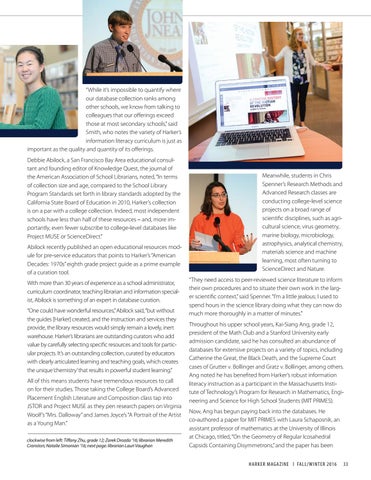“While it’s impossible to quantify where our database collection ranks among other schools, we know from talking to colleagues that our offerings exceed those at most secondary schools,” said Smith, who notes the variety of Harker’s information literacy curriculum is just as important as the quality and quantity of its offerings. Debbie Abilock, a San Francisco Bay Area educational consultant and founding editor of Knowledge Quest, the journal of the American Association of School Librarians, noted, “In terms of collection size and age, compared to the School Library Program Standards set forth in library standards adopted by the California State Board of Education in 2010, Harker’s collection is on a par with a college collection. Indeed, most independent schools have less than half of these resources – and, more importantly, even fewer subscribe to college-level databases like Project MUSE or ScienceDirect.” Abilock recently published an open educational resources module for pre-service educators that points to Harker’s “American Decades: 1970s” eighth grade project guide as a prime example of a curation tool. With more than 30 years of experience as a school administrator, curriculum coordinator, teaching librarian and information specialist, Abilock is something of an expert in database curation. “One could have wonderful resources,” Abilock said, “but without the guides [Harker] created, and the instruction and services they provide, the library resources would simply remain a lovely, inert warehouse. Harker’s librarians are outstanding curators who add value by carefully selecting specific resources and tools for particular projects. It’s an outstanding collection, curated by educators with clearly articulated learning and teaching goals, which creates the unique ‘chemistry’ that results in powerful student learning.” All of this means students have tremendous resources to call on for their studies. Those taking the College Board’s Advanced Placement English Literature and Composition class tap into JSTOR and Project MUSE as they pen research papers on Virginia Woolf’s “Mrs. Dalloway” and James Joyce’s “A Portrait of the Artist as a Young Man.” clockwise from left: Tiffany Zhu, grade 12; Zarek Drozda ‘16; librarian Meredith Cranston; Natalie Simonian ‘16; next page: librarian Lauri Vaughan
Meanwhile, students in Chris Spenner’s Research Methods and Advanced Research classes are conducting college-level science projects on a broad range of scientific disciplines, such as agricultural science, virus geometry, marine biology, microbiology, astrophysics, analytical chemistry, materials science and machine learning, most often turning to ScienceDirect and Nature. “They need access to peer-reviewed science literature to inform their own procedures and to situate their own work in the larger scientific context,” said Spenner. “I’m a little jealous; I used to spend hours in the science library doing what they can now do much more thoroughly in a matter of minutes.” Throughout his upper school years, Kai-Siang Ang, grade 12, president of the Math Club and a Stanford University early admission candidate, said he has consulted an abundance of databases for extensive projects on a variety of topics, including Catherine the Great, the Black Death, and the Supreme Court cases of Grutter v. Bollinger and Gratz v. Bollinger, among others. Ang noted he has benefited from Harker’s robust information literacy instruction as a participant in the Massachusetts Institute of Technology’s Program for Research in Mathematics, Engineering and Science for High School Students (MIT PRIMES). Now, Ang has begun paying back into the databases. He co-authored a paper for MIT PRIMES with Laura Schaposnik, an assistant professor of mathematics at the University of Illinois at Chicago, titled, “On the Geometry of Regular Icosahedral Capsids Containing Disymmetrons,” and the paper has been H AR KE R MAG A Z INE l FALL/WIN TER 2016
33
